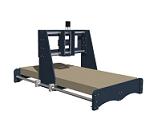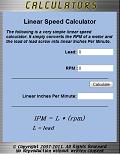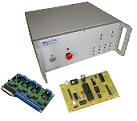 |
 |
|
The ACME nutThe ACME nut completes the lead screw system. It converts the rotary motion of the lead screw to linear motion. As with the lead screw lets cover the basics fist. As with the lead screw lets cover the basics fist. The terminology for the nut is all the same as that of the lead screw. You should know the meaning of lead, starts, pitch, and minor and major diameter. You must match these attributes with the lead screw to insure proper function. More on design considerations may be mound here. Material TypesThere are three primary types of materials used to make ACME nuts, bronze, plastic, and steel. However, only plastic and bronze nuts are used in motion control applications as steel nuts on steel lead screws would gall under high loads and speed. SteelSteel nuts are the cheapest of the three types but should never be used for motion control. Steel nuts should be used for small adjustments and for static applications. PlasticPlastic ACME nuts cover a wide range of nut materials. Plastic nuts could refer to nylon, Delrin, or other polymers. Most plastic nuts will be made of Delrin or similar hard plastics. Plastic nuts offer the lowest friction of the three. Some plastic nuts offer a coefficient of friction as low as 0.1. Plastic nuts can handle moderately high loads but not as high as bronze nuts. Check the manufacturer for load ratings. The plastic nuts may fail under shock loads, but there should be minimal shock loading on a properly operated router. Bronze There are two types of bronze material plain and sintered. All bronze nuts offers high wear resistively and the ability withstand high shock loads. Although the nut wear is less, the lead screw wear is greater. The friction of bronze on steel is higher than plastic on steel, resulting in a less efficient system. Plain bronze on steel has a coefficient of friction of about .30. Sintered bronze is oil impregnated and offers a lower coefficient of friction, usually of about .25. With sintered bronze, the higher the load the more efficient the system becomes as the oil is released. Classes of the ACME NutThere are two classes of nuts used in motion control, standard and anti-backlash nuts. Standard nuts are similar to any other nut in that they do not offer any feature to overcome backlash. There are precision standard nuts offered by many manufacturers that have very tight tolerances. However, without an anti-backlash mechanism, as the nut wears, the backlash in the system will increase. It is not recommended to use standard nuts on systems unless the overall precision and accuracy requirements of the machine are low. The next section will cover anti backlash nuts in greater detail. We will also discuss where to buy standard and anti-backlash nuts as well as how to make your own anti-backlash nut. Continue To: The Anti-Backlash ACME nut |
The Builder's Guide
 Calculators
 CNC Controllers
 |
|
|
[?] Subscribe To This Site
Page Missing?Please bare with us as we upload pages. The website is still under contruction and new content is being added. To see the most recent pages, visit the website blog. Thank you! |
||
|
|
Homepage |
Buyer's Guide |
Builder's Guide |
Contact Us|
© Copyright 2007-2011. |
||
|
|
||



